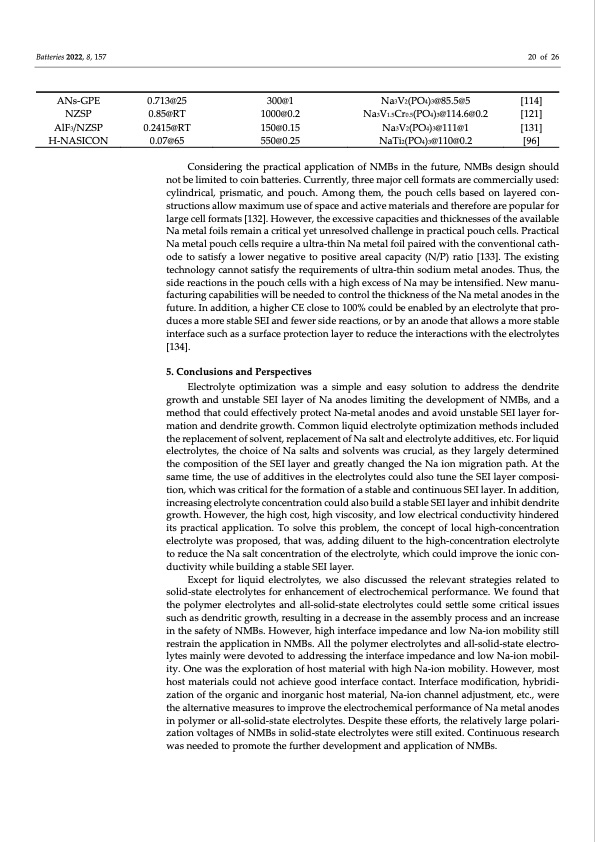
PDF Publication Title:
Text from PDF Page: 020
Batteries 2022, 8, 157 20 of 26 ANs‐GPE 0.713@25 NZSP 0.85@RT AlF3/NZSP 0.2415@RT H‐NASICON 0.07@65 300@1 1000@0.2 150@0.15 550@0.25 Na3V2(PO4)3@85.5@5 Na3V1.5Cr0.5(PO4)3@114.6@0.2 Na3V2(PO4)3@111@1 NaTi2(PO4)3@110@0.2 [114] [121] [131] [96] Considering the practical not be limited to coin batteries. cylindrical, prismatic, and pouch. Among them, the pouch cells based on layered con‐ structions allow maximum use of space and active materials and therefore are popular for large cell formats [132]. However, the excessive capacities and thicknesses of the available Na metal foils remain a critical yet unresolved challenge in practical pouch cells. Practical Na metal pouch cells require a ultra‐thin Na metal foil paired with the conventional cath‐ ode to satisfy a lower negative to positive areal capacity (N/P) ratio [133]. The existing technology cannot satisfy the requirements of ultra‐thin sodium metal anodes. Thus, the side reactions in the pouch cells with a high excess of Na may be intensified. New manu‐ facturing capabilities will be needed to control the thickness of the Na metal anodes in the future. In addition, a higher CE close to 100% could be enabled by an electrolyte that pro‐ duces a more stable SEI and fewer side reactions, or by an anode that allows a more stable interface such as a surface protection layer to reduce the interactions with the electrolytes [134]. 5. Conclusions and Perspectives Electrolyte optimization was a simple and easy solution to address the dendrite growth and unstable SEI layer of Na anodes limiting the development of NMBs, and a method that could effectively protect Na‐metal anodes and avoid unstable SEI layer for‐ mation and dendrite growth. Common liquid electrolyte optimization methods included the replacement of solvent, replacement of Na salt and electrolyte additives, etc. For liquid electrolytes, the choice of Na salts and solvents was crucial, as they largely determined the composition of the SEI layer and greatly changed the Na ion migration path. At the same time, the use of additives in the electrolytes could also tune the SEI layer composi‐ tion, which was critical for the formation of a stable and continuous SEI layer. In addition, increasing electrolyte concentration could also build a stable SEI layer and inhibit dendrite growth. However, the high cost, high viscosity, and low electrical conductivity hindered its practical application. To solve this problem, the concept of local high‐concentration electrolyte was proposed, that was, adding diluent to the high‐concentration electrolyte to reduce the Na salt concentration of the electrolyte, which could improve the ionic con‐ ductivity while building a stable SEI layer. Except for liquid electrolytes, we also discussed the relevant strategies related to solid‐state electrolytes for enhancement of electrochemical performance. We found that the polymer electrolytes and all‐solid‐state electrolytes could settle some critical issues such as dendritic growth, resulting in a decrease in the assembly process and an increase in the safety of NMBs. However, high interface impedance and low Na‐ion mobility still restrain the application in NMBs. All the polymer electrolytes and all‐solid‐state electro‐ lytes mainly were devoted to addressing the interface impedance and low Na‐ion mobil‐ ity. One was the exploration of host material with high Na‐ion mobility. However, most host materials could not achieve good interface contact. Interface modification, hybridi‐ zation of the organic and inorganic host material, Na‐ion channel adjustment, etc., were the alternative measures to improve the electrochemical performance of Na metal anodes in polymer or all‐solid‐state electrolytes. Despite these efforts, the relatively large polari‐ zation voltages of NMBs in solid‐state electrolytes were still exited. Continuous research was needed to promote the further development and application of NMBs. application of NMBs in the future, NMBs design should Currently, three major cell formats are commercially used:PDF Image | Electrolyte Engineering for Sodium Metal Batteries

PDF Search Title:
Electrolyte Engineering for Sodium Metal BatteriesOriginal File Name Searched:
batteries-08-00157.pdfDIY PDF Search: Google It | Yahoo | Bing
Product and Development Focus for Salgenx
Redox Flow Battery Technology: With the advent of the new USA tax credits for producing and selling batteries ($35/kW) we are focussing on a simple flow battery using shipping containers as the modular electrolyte storage units with tax credits up to $140,000 per system. Our main focus is on the salt battery. This battery can be used for both thermal and electrical storage applications. We call it the Cogeneration Battery or Cogen Battery. One project is converting salt (brine) based water conditioners to simultaneously produce power. In addition, there are many opportunities to extract Lithium from brine (salt lakes, groundwater, and producer water).Salt water or brine are huge sources for lithium. Most of the worlds lithium is acquired from a brine source. It's even in seawater in a low concentration. Brine is also a byproduct of huge powerplants, which can now use that as an electrolyte and a huge flow battery (which allows storage at the source).We welcome any business and equipment inquiries, as well as licensing our flow battery manufacturing.| CONTACT TEL: 608-238-6001 Email: greg@salgenx.com | RSS | AMP |